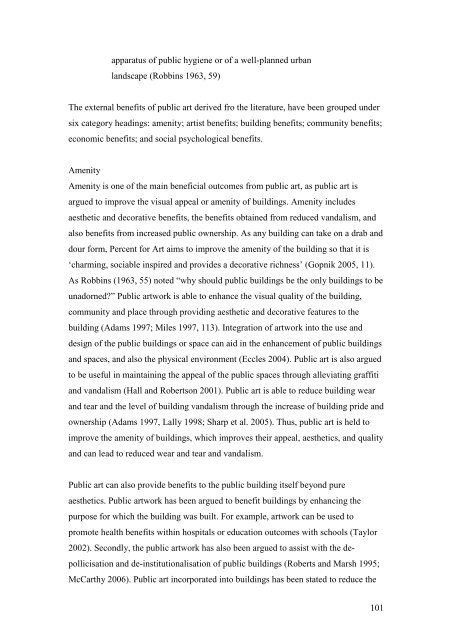Multi Outcome Construction Policy (final report)
Multi Outcome Construction Policy (final report)
Multi Outcome Construction Policy (final report)
Create successful ePaper yourself
Turn your PDF publications into a flip-book with our unique Google optimized e-Paper software.
apparatus of public hygiene or of a well-planned urbanlandscape (Robbins 1963, 59)The external benefits of public art derived fro the literature, have been grouped undersix category headings: amenity; artist benefits; building benefits; community benefits;economic benefits; and social psychological benefits.AmenityAmenity is one of the main beneficial outcomes from public art, as public art isargued to improve the visual appeal or amenity of buildings. Amenity includesaesthetic and decorative benefits, the benefits obtained from reduced vandalism, andalso benefits from increased public ownership. As any building can take on a drab anddour form, Percent for Art aims to improve the amenity of the building so that it is‘charming, sociable inspired and provides a decorative richness’ (Gopnik 2005, 11).As Robbins (1963, 55) noted “why should public buildings be the only buildings to beunadorned?” Public artwork is able to enhance the visual quality of the building,community and place through providing aesthetic and decorative features to thebuilding (Adams 1997; Miles 1997, 113). Integration of artwork into the use anddesign of the public buildings or space can aid in the enhancement of public buildingsand spaces, and also the physical environment (Eccles 2004). Public art is also arguedto be useful in maintaining the appeal of the public spaces through alleviating graffitiand vandalism (Hall and Robertson 2001). Public art is able to reduce building wearand tear and the level of building vandalism through the increase of building pride andownership (Adams 1997, Lally 1998; Sharp et al. 2005). Thus, public art is held toimprove the amenity of buildings, which improves their appeal, aesthetics, and qualityand can lead to reduced wear and tear and vandalism.Public art can also provide benefits to the public building itself beyond pureaesthetics. Public artwork has been argued to benefit buildings by enhancing thepurpose for which the building was built. For example, artwork can be used topromote health benefits within hospitals or education outcomes with schools (Taylor2002). Secondly, the public artwork has also been argued to assist with the depollicisationand de-institutionalisation of public buildings (Roberts and Marsh 1995;McCarthy 2006). Public art incorporated into buildings has been stated to reduce the101
















